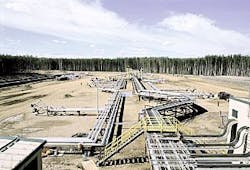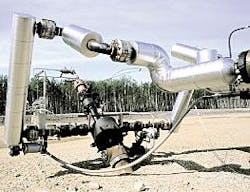In September, Petro-Canada started injecting steam in its $290-million (Can.) MacKay River steam-assisted gravity drainage (SAGD) project that will recover bitumen from oil sands lying at about a 100-m depth (Fig. 1).
The company said "The project is the largest commercial operation of its kind in Canada and a state-of-the-art plant in terms of environmental efficiency and responsible development."
Petro-Canada has a 100% working interest in the project.
The $290-million cost does not include the cost for the TransCanada PipeLines Ltd.'s co-generation facility that will provide power for the project and Enbridge Inc.'s pipeline lateral connecting the project to Enbridge's existing Athabasca pipeline.
MacKay River
Construction of the MacKay River oil sands facility began in September 2000. Petro-Canada expects the project, about 60 km, northwest of Fort McMurray, Alta., to begin producing bitumen by yearend 2002, with ramp-up to 30,000 b/d of bitumen by yearend 2003.
During the evaluation phase of the project, Petro-Canada drilled more than 200 delineation wells and acquired about 160 km of seismic.
It concluded that the development area contains about 230-300 million bbl of recoverable bitumen, which is enough to produce 30,000 b/d of bitumen for 25 years.
Petro-Canada said SAGD significantly improves bitumen recovery rates to more than 60% of original oil in place compared with an average recovery factor of 18-25% with conventional thermal recovery methods.
Brant Sangster, Petro-Canada senior vice-president, oil sands said that the project includes such features as electricity cogeneration, 90% water recycling, minimal surface impact, responsible development, and reduced emissions.
Petro-Canada expects a $6/bbl operating costs if gas prices are $4/MMscf and post start-up capital costs of about $500 million over 25 years.
SAGD involves drilling a pair of horizontal wells into the oil-bearing formation, one horizontal lateral on top of the other (Fig. 2).
In the process, steam is injected into the upper well where it heats and mobilizes the bitumen into the lower well.
The steam condenses back to water and flows to the surface along with the bitumen through the lower production well. Surface production facilities (Fig. 3) separate the water from the bitumen, treat the water, and generate steam for injection.
In Mackay River, the lateral sections of the two parallel wells are about 5 m apart, and extend up to 750 m from a centrally located well production pads (Fig. 4).
The project has 25 initial well pairs, grouped on two production pads. Because the oil sands are at a shallow depth, Petro-Canada drilled the wells with a slant drilling rig, resulting in the wellheads sitting at an angle (Fig. 5).
As wells mature and are shut in, it plans to progressively reclaim and reforest the well pads and drill additional wells from new pads.
Petro-Canada expects each well pair to produce bitumen at a rate of about 1,200 b/d, each well producing for an average 6-8 years.
After the production facilities recover the bitumen, the bitumen enters Enbridge's insulated 12-in., 35-km lateral that carries the bitumen to Enbridge's 530-km Athabasca pipeline. From there, the bitumen is diluted and travels to Hardisty, a major Alberta distribution hub, and onward to American and eastern Canadian markets.
Petro-Canada partnered with TransCanada PipeLines Ltd. to have TransCanada build a $135 million, 165-Mw natural gas-fired co-generation power plant to supply all power requirements for the MacKay River project, and supply about 155 Mw for the province.
TransCanada owns the cogeneration facility.
Other projects
Petro-Canada has filed regulatory applications with the Alberta Energy and Utilities Board (AEUB) and Alberta Environment for a second SAGD development at Meadow Creek, about 45 km south of Fort McMurray.
Petro-Canada has a 75% working interest in Meadow Creek, with Nexen Inc. holding the remaining 25%. It expects Meadow Creek, about 45 km south of Fort McMurray, to produce up to 80,000 b/d of bitumen for 25 years, beginning in 2007.
The project is expected to cost $700-800 million.
Petro-Canada also has applied to convert its refinery in Strathcona County, east of Edmonton, to process and refine 85,000 b/d of heavy oil.
A possible second phase of the refinery conversion would add a further 85,000 b/d of bitumen capacity, increasing the total bitumen handling capability to 170,000 b/d by 2010. It estimates that $4-5 billion will be required to reconfigure the refinery.
It also plans for a third, as-yet-undetermined SAGD development about the same time as the second phase of the refinery conversion.







